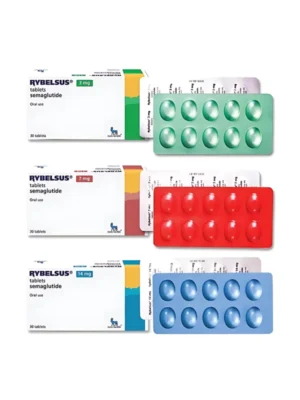Description
Glypride Tablet (Glimepiride) – Treatment for Type 2 Diabetes Mellitus
Glypride Tablet is an oral antidiabetic medication belonging to the sulfonylurea class, prescribed to manage Type 2 Diabetes Mellitus in adults. It effectively lowers blood sugar levels by stimulating insulin release from the pancreas, reducing risks of severe complications like kidney damage, nerve disorders, and vision problems. This tablet is typically taken once daily with the first meal and works best when combined with a balanced diet and regular exercise. Unlike insulin-dependent treatments, Glypride Tablet is suitable for non-insulin-dependent diabetes patients. However, it requires consistent use—even when blood sugar levels are stable—to prevent sudden spikes. Always follow your doctor’s dosage recommendations, as adjustments may be needed based on periodic blood sugar monitoring.
Uses of Glypride Tablet:
Benefits of Glypride Tablet:
- Stimulates pancreatic insulin secretion
- Reduces long-term diabetes complications
- Convenient once-daily dosage
Side Effects of Glypride Tablet:
- Hypoglycemia (low blood sugar)
- Headache
- Nausea
- Dizziness
- Weakness
How to Use Glypride Tablet?
Take the Tablet with the first meal of the day, as directed by your doctor. Swallow the tablet whole—do not crush, chew, or break it. Consistency in timing is crucial for optimal results. The dosage may vary (1–8 mg daily) based on your blood sugar levels and medical condition.
How Glypride Tablet Works?
The Tablet contains Glimepiride, which binds to pancreatic beta cells to stimulate insulin release. This process enhances glucose uptake by cells, effectively lowering blood sugar levels. Unlike metformin, it directly increases insulin production rather than improving insulin sensitivity.
Safety Advice:
- Alcohol: Unsafe—raises hypoglycemia risk.
- Pregnancy: Avoid—potential harm to the fetus.
- Breastfeeding: Not recommended—may pass into breastmilk.
- Driving: Caution advised—low/high blood sugar can impair alertness.
- Kidney/Liver Disease: Contraindicated in severe cases—dose adjustment needed for mild-to-moderate conditions.
What If You Missed a Dose?
Skip the missed dose and resume your regular schedule. Do not double the dose to compensate. Monitor blood sugar levels closely if a dose is missed.
FAQs:
Q1. What is the dosage of Glypride Tablet?
The typical starting dose is 1–2 mg once daily with breakfast. Maximum dose: 8 mg/day. Elderly or kidney-impaired patients start at 1 mg.
Q2. Does Glypride make you sleepy?
No, but hypoglycemia (a side effect) may cause drowsiness or sleep disturbances.
Q3. Is the Tablet safe for kidneys?
Safe in normal kidney function. Avoid in severe kidney disease—it’s excreted renally.
Q4. Does Glypride cause memory loss?
No, but severe hypoglycemia may affect concentration temporarily.
Q5. Who should not take Glypride Tablet?
Patients with Type 1 diabetes, severe kidney/liver disease, G6PD deficiency, or those pregnant/breastfeeding should avoid it.
Q6. How long does Glypride Tablet take to work?
Starts lowering blood sugar within 2–3 hours, though effects may not be immediately noticeable.
Q7. Can I stop Glypride once my sugar levels normalize?
No—diabetes requires lifelong management. Stopping abruptly may worsen blood sugar control.
Q8. What happens in an overdose?
Severe hypoglycemia may occur. Consume sugar immediately and seek emergency medical help.








There are no reviews yet.